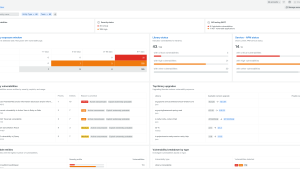Application security revolves around finding and fixing vulnerabilities within software applications. As the number and complexity of applications continues to rise, ensuring their security becomes increasingly crucial. From safeguarding user data to preventing malicious activities, the importance of application security is key to delivering a great user experience and business growth.
What are application security vulnerabilities?
Let's break it down: What are application security vulnerabilities? Simply put, they are the soft spots in your software that unwanted intruders are searching for. These vulnerabilities could be lurking anywhere, including in the lines of code, the design backbone, or even the third-party tools integrated with the app. Exploiting these weak spots can lead to unauthorized access, modification of app functionalities, theft of sensitive data, or complete app shutdown.

10 common application security vulnerabilities
Diving into the digital realm, let's shed light on the 10 application security vulnerabilities that are often encountered.
Injection attack
What it is: When your app takes an attacker's deceptive data as a legit command. Think SQL injection.
How to resolve it: Sharpen your input filters. Set clear parameters for queries and avoid dynamic SQL tied to unchecked user inputs. Object-relational mapping (ORM) frameworks are your best friend here because they naturally fend off SQL injections.
Broken authentication
What it is: Flawed authentication pathways can let attackers play pretend as genuine users.
How to resolve it: Embrace multi-factor authentication (MFA). Tighten up session management, set robust password guidelines, and store credentials in a fortress by using advanced, salted hashing techniques.
Sensitive data exposure
What it is: Revealing private data, either during transmission or at rest, is a big no-no.
How to resolve it: Use stellar encryption, like Transport Layer Security (TLS), for data on the move. For stored data, encrypted protocols and vigilant key management are non-negotiable.
XML external entities (XXE)
What it is: Here, attackers manipulate XML parsers to snoop around for unauthorized data.
How to resolve it: Turn off XML external entity processing. Keep it simple and lean towards JSON. When XML is a must, opt for XXE-resistant libraries.
Broken access control
What it is: A breach that occurs when users venture into off-limit areas.
How to resolve it: Champion role-based access control and review permissions routinely.
Security misconfigurations
What it is: Think untouched default settings or excessive feature activation.
How to resolve it: Swap default passwords, prune non-essentials, and commit to frequent configuration checks and patches.
Cross-site scripting (XSS)
What it is: Attackers use XSS to smuggle harmful scripts into web content.
How to resolve it: Sanitize every input and output. Engage in security headers and adopt frameworks that auto-protect against harmful user input.
Insecure deserialization
What it is: Trusting and processing unreliable data can wreak havoc.
How to resolve it: Steer clear from dubious data sources. If you must, choose trusted serialization formats.
Using components with known vulnerabilities
What it is Some third-party tools can be ticking time bombs.
Resolution: Keep tools updated and undergo routine audits. Harness tools that scan for vulnerabilities in open-source components.
Insufficient logging and monitoring
What it is Gaps in tracking can let malevolent activities slip by.
How to resolve it: Embrace thorough logging with instant monitoring and alerts. Incorporate security information and event management (SIEM) systems and ensure logs are reviewed periodically.
How to assess and address application vulnerabilities
Building a robust security foundation requires methodical evaluation and consistent action. Here's your roadmap:
- Draft a security policy: Define your security blueprint.
- Catalog assets: Prioritize and chronicle all application assets.
- Embrace automated vulnerability scanning with IAST: Integrate New Relic IAST for instant vulnerability insights.
- Engage in annual code review: Dive deep with expert analysis.
- Conduct penetration testing: Simulate attacks to unveil tangible weak points.
- Engage in threat modeling: Foresee vulnerabilities.
- Stay updated with patch management: Regularly refresh with patches.
- Nurture developers: Consistent training on secure code writing.
- Establish a feedback system: Fuse vulnerability insights into the development cycle.
- Institute a bug bounty program: Reward external vulnerability spotters.
- Prioritize monitoring and logging: Maintain a vigilant watch.
- Have a battle-ready incident response plan: Always be prepared.
Reduce application vulnerabilities with New Relic IAST
With New Relic interactive application security testing (IAST), vulnerabilities don't stand a chance. By integrating directly into the application's runtime environment, New Relic IAST works tirelessly in the background, offering continuous, real-time security feedback. Empower your team to catch, address, and verify vulnerabilities swiftly and efficiently.
Stay proactive, stay informed. Boost your application's defenses and ensure a seamless user experience.
Next steps
Learn more about New Relic IAST.
Sign up for a free account today to take advantage of IAST and the 30+ other capabilities of the New Relic platform. Your free account offers 100 GB/month of data ingest, one full-platform user who can use all of our tools, and unlimited basic users who can view your data and insights.
The views expressed on this blog are those of the author and do not necessarily reflect the views of New Relic. Any solutions offered by the author are environment-specific and not part of the commercial solutions or support offered by New Relic. Please join us exclusively at the Explorers Hub (discuss.newrelic.com) for questions and support related to this blog post. This blog may contain links to content on third-party sites. By providing such links, New Relic does not adopt, guarantee, approve or endorse the information, views or products available on such sites.



